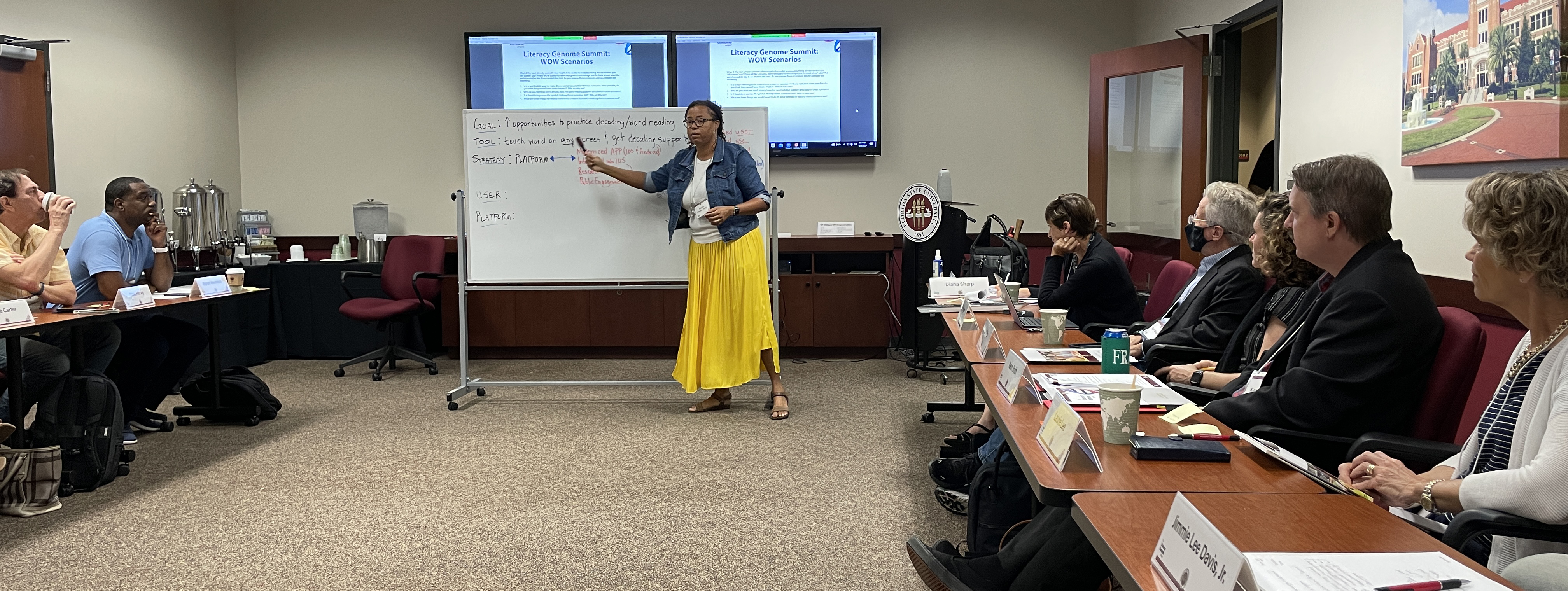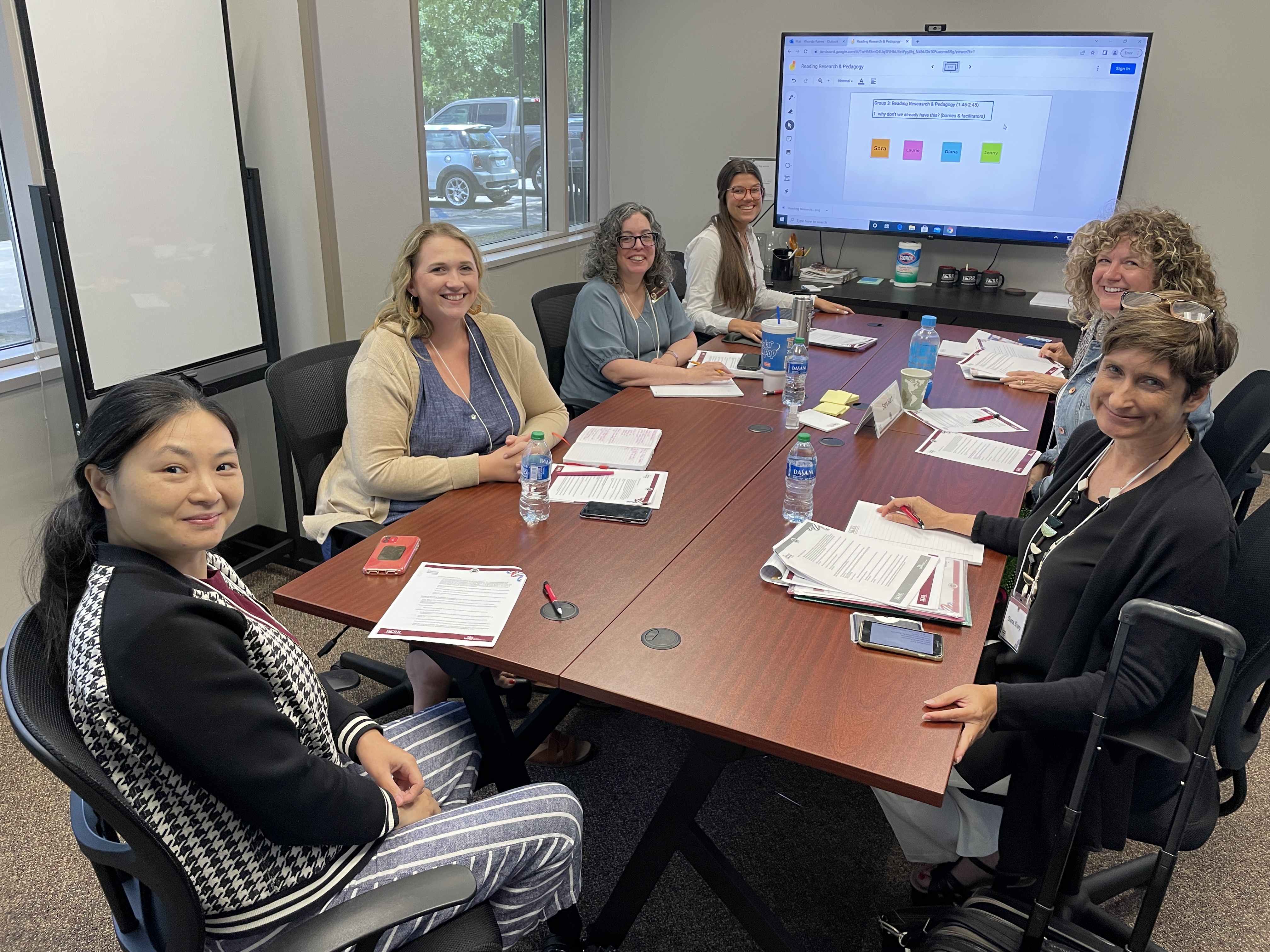Rising to the challenge: The Literacy Genome Project (LGP) takes shape at Florida State University
In 1986 an international group of researchers met to discuss and debate the audacious idea of decoding all human DNA into its fundamental units, over three billion pairs of protein chemicals. Biologists and other scientists recognized the potential power of being able to read these chemical strands as they searched for cures to human diseases. The researchers wrestled with the issues and barriers of undertaking this large-scale work. However, by the end of the conference, the leaders made the decision to pursue this vision, and the Human Genome Project, one of the greatest scientific feats in history, was born.
Distilled down, the Human Genome Project is a tool, a tool that has accelerated the study of human biology and improved the practice of medicine. Like physical diseases, illiteracy and early reading failure result in devastating limits on human potential. What if a vision of decoding language into its fundamental units, similar to the Human Genome Project’s vision of decoding DNA into its fundamental units, was applied to literacy? What if we could use this knowledge to create a tool for beginning and struggling readers to use when they encounter words they cannot read? Could we help to eliminate the limits of reading disabilities in transformative ways?
In 2021, Drs. Nicole Patton Terry, Diana Sharp, and FSU’s principal development strategist, Sonja Carter met to discuss using and adapting the agenda from that 1986 Human Genome Project conference to understand if they could create a tool that would provide every beginning and struggling reader a superpower, one that would give every reader the ability to instantly see and hear how the letters and sounds in any word go together and provide readers with the same kind of help a good teacher would give. This would afford them the power not only to read and say the new word, but the power to teach their brain how to recognize and read that word later. By the end of the meeting in 2021, the Literacy Genome Project (LGP) was born.

Creating a world-wide platform that will emulate the support of world-class human teachers or tutors is an enormous challenge. The world has many alphabetic languages, and each language has thousands of words. The scale and audacity of this vision may not be much different than what confronted the first researchers when they imagined the challenge of generating the first sequence of the human genome.
Dr. Diana Sharp first approached Dr. Nicole Patton Terry about a vision for the LGP in 2020, during the height of the pandemic and it wasn’t long before Dr. Nicole Patton Terry recognized it as a potential match for the Big Bets initiative. The Big Bets initiative is a bold experiment originating in the Office of Research at FSU, designed to connect extraordinary researchers with big-thinking funders. The initiative challenges high-impact research centers at FSU, including the Florida Center for Reading Research (FCRR), with identifying transformative ideas that could be coupled with research to achieve significant, large-scale improvement of human lives, funded by multi-million-dollar gifts.
Roughly twelve months later, twenty-two people who care deeply about literacy met at FCRR for the LGP Summit. Over a day and a half, the participants discussed and debated the feasibility of the literacy genome vision, and by the end of the summit, they made the decision to launch the LGP as a Florida State University Big Bet. The generous wisdom and expertise shared by the summit participants also provided Nicole, Diana, and Sonja with clarity on four fundamental pillars of the project.

What We Are Building
We are building a tool. We are not building a reading curriculum or a reading program. Other reading curricula or programs may one day incorporate our tool as part of their offering. But we are building a tool.
When you give someone a tool, you give them power. You enable them to accomplish a goal that is difficult or sometimes impossible without the tool. You also acknowledge their creativity, intelligence, and autonomy. You acknowledge that they may find ways to use the tool in new and unique ways: uses that even the tool’s creator never imagined and uses that may make the tool even more valuable than you ever dreamed.
The tool we are building will emulate the support that human teachers and tutors give to beginning and struggling readers. The tool will give anyone for the first time in history 24/7 access to the support of a human teacher/tutor when encountering a new word on or off the screen. The tool will provide people the power to see and hear the translation from the written word to the spoken word, and it will empower them to become self-teachers when reading independently. Critically, the tool will not replace teachers, it will simply provide the support people need to be self-teachers, in circumstances when teachers are not available to help, or in circumstances where the reader is too embarrassed to ask for help.
Why We Are Building It
Our current educational system helps many people become successful readers; however, it has proven insufficient for enabling all people to become successful readers. We believe that a just society should refuse to accept the existence of early reading failure, in the same way that that we refuse to accept the existence of physical diseases, like polio, and work to abolish them.
Further, current forms of digital support are insufficient for this purpose. Most of the time, they do not emulate the support provided by a human teacher/tutor, who is trained in the science of reading, when a child or struggling adult is reading and gets “stuck” on a word. Most digital support is designed to “tell” rather than “teach.” We believe that the distinction between “telling” support (pronouncing the whole word for the reader) and “teaching” support is a powerful distinction in relation to the cognitive experience of a beginning or struggling reader. We want to provide “tool help” versus “telling help” because of the cognitive advantages it provides beginning and struggling readers and the emotional advantages.
Who It Is For
We are building our tool for anyone who cannot read independently without struggling. Our tool is for anyone in this category who does not already have a around-the-clock human tutor to help them read anything they want to read. (Note: So far, we have not found anyone with access to such a human.)
Most people in this category are children who are beginning readers in kindergarten, first grade, and second grade. Learning to read independently takes time. Everyone who begins to learn to read struggles when they move from reading individual words in games or activities to reading meaningful sentences and longer pieces of text.
We are also building this tool to accelerate the reading growth of all children by lessening the struggle of learning to read, increasing the fun-to-work ratio of their first experiences of reading, and increasing the amount of text they read independently at those ages both in and out of school. We want to set them on the path for high levels of literacy success by giving them a better chance of choosing to read large amounts of text on their own, self-teaching and building their skills in knowledge, vocabulary, and fluency just as those who have become the most successful readers have always done.
How We Will Get There
All our processes and decisions for building this tool will align with our core values:
- Integrity of Science: The tool will need to be consistent with the recommendations for instruction from reading research that has reached a high level of consensus among learning scientists.
- Accessibility: No one will be left behind. We will conduct research to consider how the tool can be used by anyone experiencing reading failure who has the visual and auditory abilities to see and hear the support that the tool provides.
- Personalization: We believe that there is no one-size-fits-all set of instructions for providing reading support. Student agency is key, and we will consider how our tool can support users’ choices as directors of their reading and learning.
- Sustainability: We will work to ensure that our investment in this tool enables it to survive changes in technologies.
- User/Provider Focus: We will adopt an approach that “the user is always right.”
We will engage with users and providers from the beginning of our work and view them as valued members of our team who can provide input and creative strategies to guide the work. Users will be more than data points; they will be design partners.
What the Human Genome Project taught the world is that people can undertake and successfully complete enormous challenges when there is the potential to end human suffering and enrich human life. We believe the science of reading validates the value of our work, despite the enormous challenge, and that the vision of a more just and peaceful world demands we build this tool. We look forward to providing updates and progress in the coming months.





